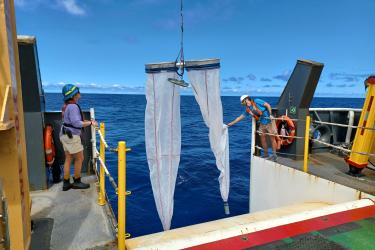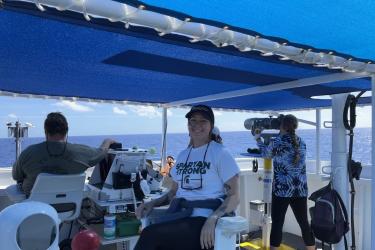“Twenty seconds… 10 seconds… 5…4…3…2…1. Our small boats have cleared testing and inspection!” We conducted annual weight tests to verify our Zodiac inflatable boats were suitable for craning operations from the ship. We will use these four 17- to 19-ft soft-hull inflatable small boats with twin 30 horsepower outboard engines during our 2021 Fall Marine Debris Mission to the Papahānaumokuākea Marine National Monument. We carefully fill each boat with its maximum weight load, lift it into the air, and begin our static 5-minute countdown. This critical step ensures our boats are safe and ready for the field—just one of the many tasks we have been working on as Marine Debris Technicians this summer.
Over the past couple of months, we have been prepping ourselves and our gear to ensure a successful upcoming field mission. Every day presents new learning experiences that keep the work exciting and varied. Some days our work involves online training such as Government Vehicle Defensive Driving or NOAA Information Technology Security to ensure we are safe employees. Other days, we take inventory of our existing gear, organize it, and purchase any additional items we need. Some of my favorite days are those where we get experience being novice boat mechanics. We have learned how to complete a regular 100-hour oil change, how to repair/replace or even completely disassemble boat engines, and how to conduct basic troubleshooting on electrical, fuel, and steering systems!
We have also been honing our skills for work on the water. Marine Debris Technician Charley Westbrook says some of his favorite and most impactful moments have been from our Marine Debris Specialized Task Endorsement Training. We conduct this 2-week intensive training in Kāneʻohe Bay on Oahu. As a team, we learn practical skills and address unlikely rescue scenarios we may encounter in Papahānaumokuākea. Charley recollects that “some of the most impactful moments were also some of the most exhausting... Simulating an open-water rescue on Ari (a Veteran Marine Debris Team member), where we towed him through the surf zone around Kapapa Island in Kaneohe Bay, was intense. Even if it was exhausting, it really boosted my confidence in the team's ability to rescue one another if such a situation came up.” During Specialized Task Endorsement Training, we spent a significant amount of time working on tow-boarding, a survey technique we plan on using during our 2021 Marine Debris Mission. Tow-boarding is exactly as it sounds! Two divers are slowly towed behind a boat as they search for underwater debris. Some of Charley’s most enjoyable moments were during this training; “the amount of reef you could see on a single breath-hold was mind-blowing. Swooping and flying around coral colonies and over open sand patches was a blast and made me feel like a Star Wars pod racer at times.”
During the final stretch of our cruise preparations, better known as “Crunch Week,” the team worked furiously to finalize all boat preparation, packing, and miscellaneous tasks, before loading the gear. We worked through problems on each boat that arose during our Specialized Task Endorsement Training, put the finishing touches on our emergency kits and supplies for the trip, and finished all of our last-minute purchasing for the 2021 field season. I learned so much during this week and our veteran crew members were incredible teachers! Now, we all eagerly sit through a 10-day mandatory stay-at-home, self-isolation quarantine, which includes COVID-19 testing, virtual meetings, and personal packing/preparation. After this, we will safely board the Imua (our ship) and head to Papahānaumokuākea Marine National Monument where we will remove marine debris!





